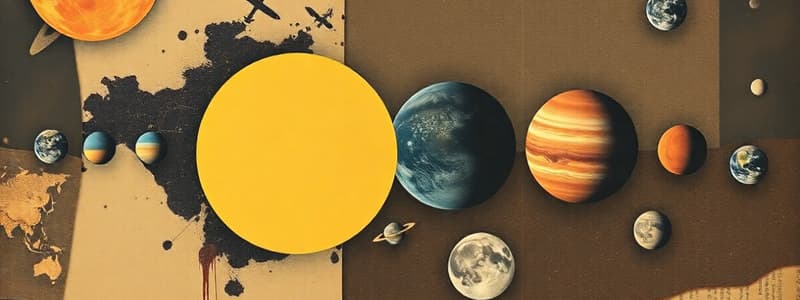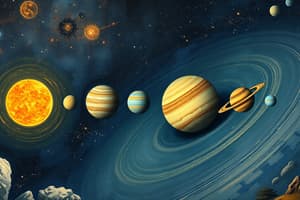Podcast
Questions and Answers
What primarily defines a celestial body as a planet?
What primarily defines a celestial body as a planet?
- Its spherical shape and cleared orbital path around a star (correct)
- Its size and proximity to other celestial bodies
- Its composition, whether it's made of rock or gas
- Its ability to emit light and heat
How many planets are officially recognized in our solar system?
How many planets are officially recognized in our solar system?
- Seven
- Nine
- Eight (correct)
- Ten
Which mnemonic device helps in remembering the order of planets?
Which mnemonic device helps in remembering the order of planets?
- Mary's Violet Eyes Make John Stay Up Nights
- My Very Educated Mother Just Served Us Nachos (correct)
- Many Very Eager Monkeys Jump Swiftly Underneath Noodles
- Mark's Very Energetic Mouse Just Sat Underneath Neptune
Which planet is closest to the sun?
Which planet is closest to the sun?
What are the two main categories of planets in our solar system?
What are the two main categories of planets in our solar system?
What characterizes terrestrial planets?
What characterizes terrestrial planets?
Which planets are classified as terrestrial?
Which planets are classified as terrestrial?
What is an atmosphere?
What is an atmosphere?
What primarily distinguishes Jovian planets from terrestrial planets?
What primarily distinguishes Jovian planets from terrestrial planets?
What is the defining characteristic of a moon?
What is the defining characteristic of a moon?
How many of Jupiter's moons have officially been confirmed by NASA as of early 2022?
How many of Jupiter's moons have officially been confirmed by NASA as of early 2022?
Which celestial body is classified as a minor planet?
Which celestial body is classified as a minor planet?
What causes a comet to develop a tail?
What causes a comet to develop a tail?
What distinguishes a meteorite from a meteoroid?
What distinguishes a meteorite from a meteoroid?
What phenomenon is responsible for a meteor's heating as it enters Earth's atmosphere?
What phenomenon is responsible for a meteor's heating as it enters Earth's atmosphere?
Flashcards
Solar System
Solar System
A collection of celestial bodies, including the sun and planets, orbiting it.
Planets
Planets
Celestial bodies that orbit the sun and are spherical due to gravity.
Number of Planets
Number of Planets
The solar system has eight recognized planets as of 2006.
Terrestrial Planets
Terrestrial Planets
Signup and view all the flashcards
Jovian Planets
Jovian Planets
Signup and view all the flashcards
Gravity's Role
Gravity's Role
Signup and view all the flashcards
Pluto's Demotion
Pluto's Demotion
Signup and view all the flashcards
Mercury
Mercury
Signup and view all the flashcards
Gas giants
Gas giants
Signup and view all the flashcards
Moons
Moons
Signup and view all the flashcards
Meteor
Meteor
Signup and view all the flashcards
Meteoroid
Meteoroid
Signup and view all the flashcards
Meteorite
Meteorite
Signup and view all the flashcards
Comets
Comets
Signup and view all the flashcards
Study Notes
Solar System Overview
- The solar system includes the Sun and eight planets, and other celestial bodies like moons, asteroids, comets, meteoroids, dwarf planets, and meteorites.
- The Milky Way Galaxy contains an estimated 3,200 solar systems.
- The definition of a planet is in flux; current criteria: orbits the Sun, has enough gravity to take a spherical shape, and has cleared out its orbital path.
Defining Planets
- To be classified as a planet, a celestial body must meet specific criteria; orbit the Sun, have enough gravity for a spherical shape, and clear its orbital path.
- In 2006, Pluto was reclassified as a dwarf planet, reducing the number of known planets to eight.
- A common mnemonic for remembering the order of the planets is "My Very Educated Mother Just Served Us Nachos".
Planet Categorization
- Planets are categorized as either terrestrial or Jovian.
- Terrestrial planets (Mercury, Venus, Earth, Mars): solid surface, rocky composition, relatively smaller, metal core, have an atmosphere.
- Jovian planets (Jupiter, Saturn, Uranus, Neptune): gaseous composition, no solid surface, larger than terrestrial planets, nicknamed gas giants.
Moons
- Moons orbit planets, not the Sun, and are spherical due to their gravity.
- Earth has one prominent moon; some planets have no moons, others have multiple.
- Jupiter has an estimated 79 moons, with 53 confirmed by NASA.
Smaller Solar System Bodies
- Meteoroids: small celestial bodies floating in space.
- Asteroids: larger, rocky or metallic objects orbiting the Sun, often found in the asteroid belt; considered minor planets.
- Comets: icy bodies of gas, rock, and dust that orbit the Sun in elliptical paths; often develop tails as they approach the Sun. There are approximately 3,743 known comets (as of early 2022).
Meteors, Meteorites, and Meteoroids
- Meteoroids become meteors when entering Earth's atmosphere. Friction heats them up, creating a bright streak (shooting star).
- Most meteors disintegrate in the atmosphere.
- Remaining material that hits the ground is a meteorite.
- These are different stages of the same celestial body.
Studying That Suits You
Use AI to generate personalized quizzes and flashcards to suit your learning preferences.




